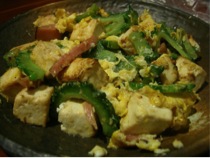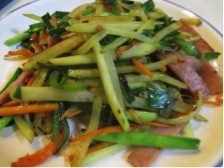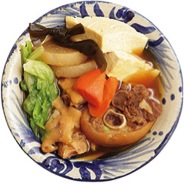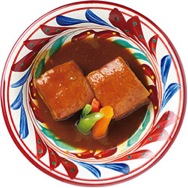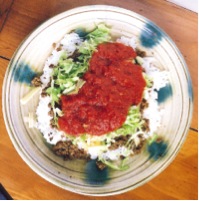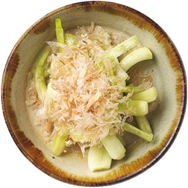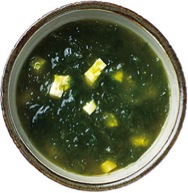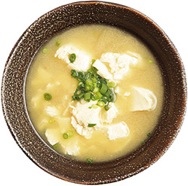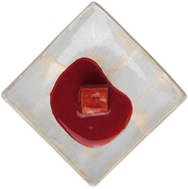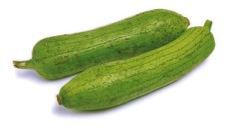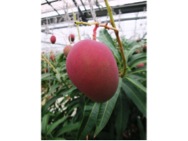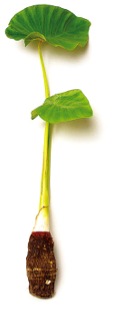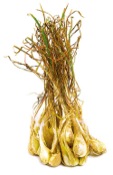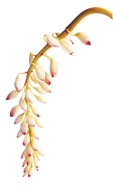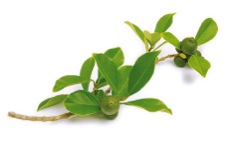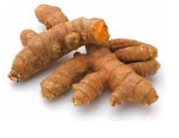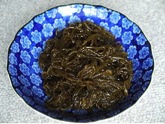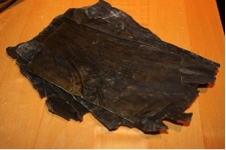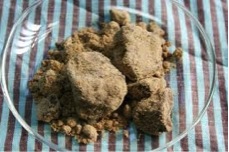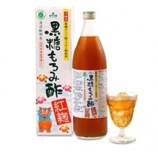Food Options in Okinawa
| Food Options in Okinawa |
Okinawa is an island rich in culinary history. Okinawan cuisine, also known as Ryukyuan cuisine (a reference to the Ryukyu Kingdom differs from mainland Japanese cuisine due to differences in culture, historical contact between other regions, climate, vegetables and other ingredients. Okinawan cuisine incorporates influences from Chinese cuisine and Southeast Asian cuisine due to its long history of trade. Despite being surrounded by the sea, Okinawans eat relatively little seafood compared to other maritime cultures. Fish and other seafood products were traditionally difficult to preserve in the high temperatures of the Okinawan islands. Additionally, the islands are surrounded by relatively few fish species.
| Typical Okinawan Dishes |
Goya Champuru |
|
|
Goya champuru is one of the most common of champuru. Translated as “bittermelon” and in season during the summer, goya has a green skin and bitter taste. Served at many restaurants, Goya champuru includes goya, tofu, pork, eggs, salt and soy sauce. Goya gives the champuru an exotic flavor and a healthy quality |
|
Fu Champuru |
|
|
Stir-fried vegetables with fu (wheat gluten), a very healthy food rich in vegetable protein and often used in Asian food. Champuru means “to mix together”, and stir-fried fu champuru is one of Okinawa’s main such dishes. Found at local restaurants serving Okinawan food and at local grocery stores. |
|
Tofu Champuru |
|
|
The flavor of tofu champuru is similar to that of goya champuru. There are not many differences between the two, although in this case tofu is the main ingredient. It is seasoned with salt and soy sauce. |
|
Papaya Champuru |
|
|
Although a fruit, papaya is often used like a vegetable. When added to champuru, papaya is cut into thin strips, fried and mixed with carrots and other vegetables as well as with tuna or canned pork. It is then seasoned with salt and soy sauce. Resembling a cut-up potato, papaya is said to be good for the health. |
|
Tebichi no Nitsuke |
|
|
Tebichi boiled with carrots, daikon (Japanese radish), tofu and konbu (seaweed) and seasoned with soy sauce. Tebichi means “pig’s feet” in the Okinawan dialect. Nitsuke describes a kind of food that is boiled and seasoned with such condiments as soy sauce. Tebichi produces a rich gelatin when boiled and helps keep your skin young. |
|
Rafute |
|
|
A traditional Okinawan dish in which chopped pork belly is slowly simmered with soy sauce or miso, brown sugar and awamori. The pork becomes tender and free of extra fat because of the long cooking time. |
|
Umibudo |
|
|
A variety of seaweed found in the waters surrounding Okinawa. “Umi” means sea and “budo” means grapes in Japanese. This seeweed resembles grapes and is eaten after dipping it in vinegar soy souce and ponzu (citrus vinegar) |
|
Taco Rice |
|
|
Taco Rice is an Okinawan dish using taco ingredients that have been put on rice. Despite the origins of the taco and the American fast food chain Taco Bell, taco rice is believed to have been created in Okinawa and has become an integral part of the island’s food culture. |
|
Shima rakkyo (Okinawan shallots) |
|
|
Compared with their counterparts in the mainland, Okinawan shallots are smaller in size and much stronger in aroma. Normally served with flakes of dried bonito and soy sauce after light pickling with salt. Also good for tempura. |
|
Fuchiba Jushi |
|
|
Fuchiba is Okinawan dialect for mugwort leaves, and jushi is a rice dish prepared with a choice of ingredients including pork and vegetables. Fuchiba jushi is ofetn served as a side dish to Okinawa soba at local eateries. Mugwort is an herb with a characteristic aroma, known for its property as a natural antidote. |
|
Asa Soup |
|
|
A clear Japanese-style soup with bonito broth and a nutrient-rich sea vegetable called asa, or sea lettuce, and characterized by a refreshing scent reminiscent of the ocean. Dried asa can be purchased at shops selling local specialities as well as at most supermarkets. |
|
Yushi Dofu, Kumi Dofu |
|
|
Very soft tofu with a consistency similar to that of yogurt or pudding. It is made from soy, like regular tofu, but after nigari (from seawater) is added to liquid pressed from soybeans, it doesn’t set like hard tofu. NIgari is high in minerals such as magnesium and potassium, is often served by itself and is sometimes cooked in miso soup. It is available at local grocery stores. |
|
M. Jimami tofu |
|
|
Peanut butter tofu, made from potato starch and liquid squeezed from peanuts. A little chewy and sweet, it’s like an Okinawan dessert. You can eat it with grated ginger, wasabi, sweet soy sauce dressing or brown sugar syrup. Available at local grocery stores. |
|
Tofuyo |
|
|
A delicacy essential to court cuisine, tofuyo has a distinctively rich cheese-like texture. It is made with dried tofu that has been fermented in a mixture of awamori and red koji, a method that originated in China. A popular dish served with awamori. |
|
| Typical Okinawan Vegetables and Fruits |
Goya (Nigauri, Bitter Melon) |
|
|
Goya, characterized by its bitter taste, contains two to three times as much vitamin C as lemon. Goya is considered to be one of the key ingredients for Okinawan longevity. It retains its vitamins even after cooking and is commonly used in goya champuru, the most typical stir-fry dish in Okinawa. |
|
Nabera (hechima, loofah) |
|
|
Nabera is a summer vegetable commonly eaten like goya in Okinawa. It is rich in vitamins and minerals and is stir-fried or used in soup. |
|
Shibui (Togan, White Gourd) |
|
|
Shibui is a vine plant of the cucumber family, which grows as large as 11 pounds. It is rich in vitamin C, and its simple flavor goes well with soups and stewed dishes. |
|
Fuchiba (Yomogi, Mugwort Leaf) |
|
|
Fuchiba, widely viewed as an all-round medicine, contains an abundant amount of calcium, potassium and iron. It is effective in lowering body temperature, soothing neuralgic pain and lowering blood pressure. Its bitter flavor goes well with Okinawa soba. |
|
Papaya |
|
|
Green, or unripe, papaya is a popular food in Okinawa and is commonly used in stir-fry dishes. Green papaya is high in nutrients and considered a longevity vegetable. The enzyme papain contained in papaya aids in digestion and also has an antioxidative effect. This enzyme is contained in various depilatory products. |
|
Shima Ninjin (Okinawan Carrot) |
|
|
Okinawa is the only producer of shima ninjin in Japan. Shima ninjin, believed to be one of Okinawa’s secrets of longevity, is characterized by its long thin shape, usually 30-50 centimeters in length. It has a significant amount of vitamins A and C, potassium and iron, and is good for easing eye fatigue and improving digestion. |
|
Okinawan Mango |
|
|
Okinawa offers top-quality mangos with its perfectly balanced sweetness and beautiful aroma. The best time to eat mangos is when their skin becomes a little sticky and shiny. When you go to buy mangos, choose ones with red and yellow skin over bright red. |
|
Dragon Fruit |
|
|
A member of the cactus family identified by its distinctive skin color, dragon fruit can be grown without any pesticides or chemical fertilizers. Despite its color, the red or white flesh has a light taste. Being rich in vitamins, fiber and minerals, dragon fruit is consumed by beauty-conscious people. |
|
Taanmu (Taimo, Taro) |
|
|
An indispensable ingredient in traditional Okinawan dishes, taanmu is rich in fiber and contains more vitamin B1 and iron than milk. Prepared in a variety of ways, from steaming to frying, this plant is considered a symbol of fertility because many small taanmu are attached to the mother tuberous root. |
|
Shima Rakkyo (Okinawan Shallots) |
|
|
A member of the lily family characterized by its unique spicy flavor and crispy texture, shima rakkyo is a common ingredient for pickles in Okinawa, and it is also deep or stir-fried. It is effective in killing bacteria and cleansing the blood. |
|
Getto |
|
|
Getto is a plant commonly found in Okinawa identified by its gorgeous white flowers with pink tips. Its leaf extract is used in aromatherapy and also as a disinfectant, insecticide and preservative. In addition, the extract is beneficial for coughs as well as regulating digestive function. |
|
Shiikwaasaa (Hirami Lemon) |
|
|
Shiikwaasaa is a citrus fruit that grows in northern Okinawa, including Higashi Village, which is known as the longevity village. A component called nobiletin contained in shiikwaasaa eases rheumatism and has a growth-inhibiting effect on cancer. Concentrated shiikwaasaa juice is available. |
|
Njanaba (Nigana, Crepidiastrum Lanceolatum) |
|
|
A wild plant of the daisy family that used to grow everywhere in Okinawa, most commonly along the coastline and in rocky and sandy areas. Rich in vitamins, carotin and calcium, njanaba is believed to be effective in relieving cold symptoms, improving digestion and eliminating fatigue. Njanaba has a bitter taste. Thinly sliced njanaba is mixed with Okinawan tofu and peanut butter.
|
|
Aloe |
|
|
Aloe is a member of the lily family. Compared to kindachi aloe in the mainland, Okinawan aloe, known as aloe vera, has thicker flesh and is less bitter. Aloe vera is the type of aloe very popular in many Western countries. It is an effective skin moisturizer and is also good for treating burns and sunburn. |
|
Ucchin (ukon, turmeric) |
|
|
A member of the ginger family, ucchin has been highly valued since the days of the Ryukyu Kingdom as a traditional medicine for enhancing liver function. Other benefits include improving digestion, regulating intestinal function and cleansing the blood. Ucchin comes in capsules and powder as well as in liquid form. In Okinawa, ucchin is commonly used for hangovers. |
|
Mozuku |
|
|
Mozuku is a type of seaweed characterized by its unique viscous texture and the presence of fucoidan, which breaks down cancer cells. It is also effective in anti-aging, dead skin removal and as a skin whitener and moisturizer. |
|
Shima Tofu |
|
|
Shima tofu is two to three times firmer than mainland tofu, and it is full of high-quality vegetable protein. Tofu is an indispensable ingredient in Okinawan cooking and is used in many kinds of champuru dishes. Freshly made tofu is warm and sold in a plastic bag. Yushi dofu, very soft tofu before it has completely solidified, is also available. |
|
Konbu Seaweed |
|
|
Okinawa is Japan’s number-one consumer of konbu seaweed. Konbu is the ingredient commonly used to make broth in Okinawa, and it goes particularly very well with pork cuisine. Musubi konbu, or tied konbu, is often used in traditional as well as home cooking, including soup, stewed dishes and stir-fry. Konbu is believed to enhance longevity. |
|
Fu |
|
|
Fu is made from extracted flour protein. Okinawan fu is more nutritious than that of mainland Japan, and it is an important source of protein for Okinawans. Soak the fu in water and then in beaten egg, and fry it with vegetables and tofu to make the traditional homemade Okinawan dish, fu champuru. |
|
| Other Important Ingredients |
Brown Sugar |
|
|
Brown sugar is produced by evaporating sugarcane juice with the use of calcium carbonate to solidify the sugar. Okinawan brown sugar is rich in nutrients and contains abundant vitamins and minerals, including iron, calcium and potassium. In addition, it is believed to be effective in relieving fatigue, improving brain function and alleviating menstrual problems. |
|
Moromisu (Drinking Vinegar) |
|
|
Moromisu is a popular health product made of liquid extracted from the by-product of awamori, the king of Okinawan liquor. Being rich in citric acid and amino acids, moromisu is said to help boost metabolism and speed up weight loss. Its taste is rather mild without the strong odor of liquor.
|
|




